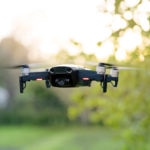Drones to stop the COVID-19 epidemic
In the era of forced social distancing as a result of the SARS-COV-2 pandemic, this technology has become one of biggest allies in the fight against the coronavirus.

In addition to big data, artificial intelligence and other tools like medical robots, drones have become the main characters in this remote battle due to their versatility and the fact that they are a fairly extended technology that is easy to implement and already in the hands of many security forces around the world. These are some of the tasks with which drones are bridging the gaps in times of pandemic.
Detecting the ill with ‘pandemic drones’
An indispensable activity to stop the pandemic is distinguishing healthy people from the sick in order to isolate the latter. To do so, thus far a person needed to be involved, in addition to the patient, in order to check their temperature and examine them, or conduct the test to detect COVID-19.
However, this first barrier for social distancing could be overcome thanks to the Vital Intelligence project, an initiative by the professional drones company Draganfly, the health data and deep learning company Vital Intelligence Inc., the University of South Australia and the Australian Department of Defense that aims to create a global technology group to fight against pandemics like COVID-19.
The goal is for these organizations to combine their technologies to fully optimize the use of drones in a pandemic. For example, these drones will integrate cameras, data services to monitor medical care and sensors to check an individual’s temperature and heart and breathing rate from a distance. They have also designed algorithms that make it possible to interpret human actions like coughing or sneezing in a context of epidemiological monitoring like the present. Although there are no tests of these mechanisms’ level of effectiveness, on paper it is a promising project that could optimize the other monitoring strategies already underway.
Drones to distribute medicine, food and medical equipment
The situation of forced isolation due the rapid spread of the SARS-COV-2 virus has precipitated the adaptation of food and package delivery systems, which are a potential source of contamination. Prior to this pandemic, countries like the United States and the Dominican Republic had already demonstrated how useful drones are when it comes to delivering vital medical supplies. During the coronavirus crisis, its utility was also confirmed in China, where companies like TerraDrones and Antwork made use of drones to transport medical samples from the Xinchang Hospital to the Center for Disease Control and Prevention in Zhejiang, three kilometers away. Apart from being a safe way to transport these types of products, drones optimize the delivery time.

Image of a TerraDrone and Antwork drone arriving at the Xinchang Hospital. - Credit: Terra Drone Co.
The coronavirus crisis has also served to propel the use of drones to deliver food. The Chinese ecommerce company JD.com has launched its group of drones to carry out several food delivery tests that replace one hour transportation times with a flight of approximately 10 minutes. To do do, they had to design flight paths, request permission to access the air space and receive the local government’s approval. These experiments demonstrate how drones can be a part of the response to public health emergencies, similar to the results of tests previously conducted to deliver blood in Rwanda and Ghana, for example.
Drones to provide information and monitor population movements
A drone with a speaker made it possible for the Madrid police to inform citizens of the rules for the state of emergency that the Spanish government put in place in early March. This combination of technology and the media is a way to also foster social distancing among government security forces, which are highly necessary to control other essential aspects during the fight against this disease. In addition, the police is using these small devices to monitor those violating the lockdown rules in different cities like Valencia and Murcia, and also to monitor the coast in beach areas during the quarantine.
Disinfecting common areas with agricultural drones
Disinfecting large areas or places that are difficult to access is also one of the essential tasks during this race against coronavirus. Dispensing with human resources in some extreme places, or reducing human intervention to the minimum are some of the benefits of using agricultural drones for these tasks.
The Spanish Military’s Emergency Unit is incorporating these unmanned aerial vehicles to conduct nebulizing tests on open areas, and large vehicles with some very satisfactory results as they describe on their website: “These drones have a 10 liter load capacity. In a standard use, they could fumigate/nebulize approximately half of a hectare or a hectare (according to the model) for each battery charge, which means this surface will be covered in 15 minutes.”
In China, this agricultural technology has also been used for the same purpose. As stated on the website of The World Economic Forum, Justin Gong, the co-founder of the XAG drone company spoke of these vehicles’ potential: “Depending on the use, spraying with drones can be 50 times more efficient than spraying done by people.”